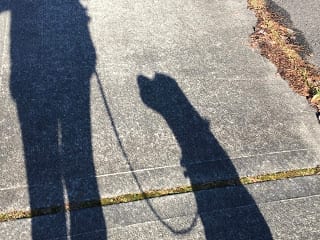
Heavy Petting
Non-stop Loving on Your Dog Could Be Causing Stress
When I have a meeting with clients on what motivates their dog’s behavior, heavy petting the dog in the family is fairly consistent. The time I spend with an initial consultation is in observation of body language, is in identifying anxiety- producing situations where communication with our dogs has possibly broken down, or has never been very strong.
As dog-loving humans, our tendency is to pet dogs that are in our vicinity. It feels good, while actually creating a physiological shift in most basic body function, regulation of blood pressure, production of feel-good hormones, and serotonin boost, to name a few. And we are aware of the importance of therapy dogs’ jobs! Monitors placed on dogs show there are times when our dogs are provided with calming physiological shifts as well, AND there are times when our dogs will exhibit quite an opposite more anxious result. This can be backing away, stretching, shaking, looking away from you. These are subtle signs to us but not to them.
Doggie Body Language Speaks Volumes
“Don’t pet me.” This doesn’t mean that they aren’t fond of us, or even that they would rather be someplace else. It simply means “I don’t wish to be pet right now” because:
“are you eating the rest of that sandwich” -or-
“just smelling who you were around today” -or-
“ready to go for that walk now” -or-
“I’m hungry” -or-
you fill in the blank…
The reason this becomes a “big deal” is that our dog’s anxiety has a tendency to expand when their body language voices are not heard. This can break down in small but significant ways their ability to trust their environment. To intrude on anthropomorphism for just a moment, if we are not being heard, we humans tend to speak louder to communicate our needs, or possibly abandon one form for another in attempt to get them met. I suggest that if a dog is consistently not being heard, there may be some form of conflict that develops as a result.
In observation mode with your dog, do an experiment. How much of the time that you reach out to your dog, does s(he) respond by backing away, turning away, stretching, shaking, or other signs of stress? Watch and you will hear! In another blog I will list stress signals to watch for with your dog, and how you can reorient this to a positive interaction. Now that you are becoming more aware of when your dog would like YOU to pet her/him, now it is time to watch for interactions with strangers. Since my dog is expert in telling me he doesn’t wish to be pet at any given time, I will follow up this blog with a video of his communication to me of such.
When a stranger or friend asks if they may pet your dog, assume that your dog is not going to enjoy a stranger touching them. Watch first what your dog’s body language is saying about that, and respond with that information. Stranger attention isn’t necessary for the wellbeing of your pup. Your dog may be just gathering information from this person you’re talking to. If you offend someone in the process by saying no to their request to pet your dog, then so be it. You may very well, as a result, have a confident, more trusting dog by your side. We don’t accept strangers touching us, and I can say with some certainty from a study of dog body language that dogs don’t always take kindly to it either.
Working Around Stranger Anxiety
If your dog has profound stranger anxiety, then by all means contact a modification specialist to work with your pup; however, recognize that even with modification of this anxiety, the end goal may not be that you ask your dog to accept stranger’s greetings. It is not the end-all and be-all of having a dog that other people get to pet them, particularly if it makes them nervous.
Consider what makes you nervous, and imagine someone forcing you to perform anything in this state of mind, and thinking anything is going to change. Now you get it. I know you do.
We may have to figure what to do to help ourselves feel better instead of heavy petting, and the payoff is deeper understanding of your relationship with your dog. Your dog’s “thank you” for listening may come to you in the form of a less anxious and more comfortable dog!
For more information, visit Your Canine Resource and call by Patti Howard, BS CCS.
“Behavioral and cardiac responses by dogs to physical human–dog contact,” Franziska Kuhner, Johanna C. Hoessler, Rainer Struwe, Journal of Veterinary Behavior: Clinical Applications and Research, May-June, 2014, Volume 9, Issue 3, pages 93-97.
“Physiological Effects of Human/Companion Animal Bonding,” Mara M. Baun, Nancy Bergstrom, Nancy F. Langston, Linda Thoma, Nursing Research, May/June 1984 – Volume 33 – Issue 3.
Handbook on Animal-Assisted Therapy: Theoretical Foundations and Guidelines, edited by Aubrey H. Fine.
